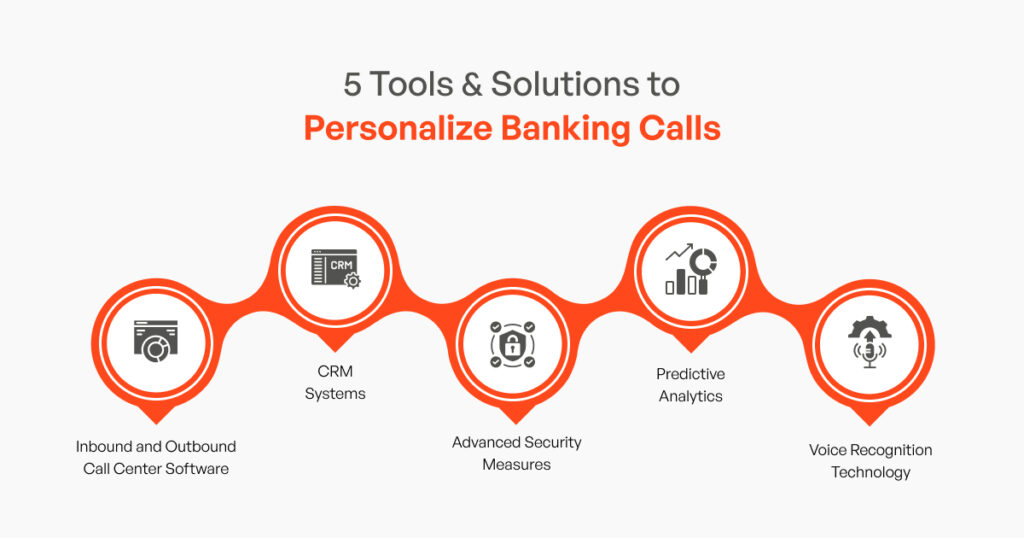Personalization Strategies for Inbound and Outbound Banking Calls: A Technology Perspective
Within the quickly changing banking industry, where the customer experience is paramount, the concept of tailored interactions has become increasingly important. Both incoming and outgoing banking calls have evolved into strategic points of contact where personalized experiences are created by fusing technology and human interaction.
A critical issue that arises when organizations use cutting-edge tools and solutions for personalization is how to protect consumer data in a time of strict regulations and increased privacy awareness.
The banking sector has seen a significant transition in this era of digital transformation from one-size-fits-all strategies to customized interactions that appeal to specific clients. The integration of technology and personalization has emerged as a fundamental element of customer engagement tactics, providing banks with a means of establishing more meaningful connections and long-lasting partnerships.
This shift is especially noticeable when it comes to incoming and outgoing banking calls, where technology is both improving the customer experience and raising issues with data security and privacy at the same time.
The Significance of Personalization in Banking Calls
Personalized interactions have a significant impact on the customer experience. In a time when clients want more than merely transactional connections, personalization becomes a crucial differentiator.

Through customized interactions based on individual preferences, transaction history, and demographic data, banks can offer their clients a distinctive and unforgettable experience.
These individualized interactions foster trust and loyalty, which are vital in the cutthroat world of banking. The observable advantages of personalization are supported by data and case studies, which demonstrate greater rates of customer retention and higher customer lifetime values.
Personalization in Inbound Banking Calls
Banks have an opportunity to demonstrate their dedication to customer-centricity when inbound calls come in. By utilizing technology, banks can use advanced inbound call center software to evaluate client information instantly and provide tailored support.

For example, a consumer calling regarding a mortgage could get personalized guidance depending on their financial background. These individualized exchanges help to improve the bank’s reputation while also resolving pressing issues. Benefits go beyond satisfied customers; agents with individualized insights can handle problems faster, leading to increased operational efficiency.
Personalization in Outbound Banking Calls
While outbound calls typically encounter obstacles like resistance and customer intrusion, personalization can turn these exchanges into worthwhile interactions. Banks can use predictive analytics with outbound call center software to find the best times to contact customers and customize messages according to their preferences.

Offering individualized product recommendations or alerting clients to impending promotions that fit their budget are two successful examples. Outbound calls can be used strategically to establish rapport and anticipate the needs of your customers by personalizing them.
Technological Tools and Solutions for Personalization
The variety of tools and solutions that banks can utilize is part of the technology perspective on personalization. The core of personalized interactions is call center software, both inbound and outbound, with advanced analytics and machine learning capabilities.

To provide a consistent view of the customer across all touchpoints, Customer Relationship Management (CRM) systems are essential for gathering and evaluating customer data.
These technological advancements enable banks to take a proactive and individualized approach by enabling them to anticipate future needs in addition to understanding individual customer preferences.
Let’s dive deeper into technological tools and solutions for enhancing personalization.
1. Inbound and Outbound Call Center Software
Personalized communication starts with specialized software made for both inbound and outbound calls. These platforms process customer data in real-time using machine learning algorithms and advanced analytics, allowing for personalized interactions based on past behaviors and individual preferences.
2. Customer Relationship Management (CRM) Systems
CRM systems are essential for gathering and organizing customer information at different points of contact. CRM systems give banks an integrated view of customer interactions, preferences, and transaction history, which helps them effectively personalize communications. Targeted engagement is made easier and the overall customer experience is improved by this technology.
3. Predictive Analytics
To predict future customer behavior, predictive analytics tools make use of machine learning algorithms and historical data. These tools assist in determining the best times to make outgoing calls in the context of banking calls, anticipate client needs, and give call center agents insightful information. Banks can anticipate customer needs and adjust their interactions by using predictive analytics.
4. Voice Recognition Technology
While making outgoing and incoming calls, voice recognition technology improves personalization. This tool helps banks understand the emotional context of the conversation by analyzing speech patterns and customer sentiment. The responses are then customized using this information, guaranteeing a more sympathetic and individualized communication style.
5. Advanced Security Measures
Because personalization depends so much on customer data, it is imperative to put strong security measures in place. Sensitive consumer data is protected by sophisticated encryption algorithms, safe data storage practices, and adherence to privacy regulations. In addition to fostering trust, these security tools guard against possible data breaches and address privacy and confidentiality issues.
Want a perfect solution for your business communication needs?
Connect with HoduSoft Expert Now!
Data Security and Privacy Concerns
Data security and privacy are of utmost importance in the age of personalized banking calls, where technology acts as a catalyst for customized customer interactions.
As financial institutions leverage customer data to provide tailored experiences, it is critical to acknowledge and allay customers’ justifiable worries about the security of their private data.
1. Robust Security Measures
In the sphere of personalization, where customer data is the cornerstone, putting strong security measures in place is not an option but an absolute requirement. Sophisticated encryption algorithms function as a barrier, making client data unintelligible to unauthorized parties. This makes sure that the data is safe and unreadable even if it is intercepted.
2. Secure Data Storage Protocols
Secure data storage practices are essential for maintaining the accuracy of customer data even in the absence of encryption. Modern technology is used by banks to safely store data, reducing the possibility of unwanted access. These protocols demonstrate the dedication to protecting the privacy and confidentiality of customer data by adhering to industry standards and laws.

3. Compliance with Privacy Standards
Banks are required to adhere to strict privacy standards and regulations since they are the guardians of confidential customer information. This compliance is a dedication to ethical data practices, not just a checkbox exercise. Banks that uphold privacy standards not only reduce legal risk but also strengthen the trust that their clients have in them.
4. Addressing Customer Concerns
Open and honest customer communication is crucial to data security and privacy. To allay customers’ fears, banks need to be proactive in communicating their policies regarding data usage. In addition to building trust, this openness enables clients to make well-informed choices about how much of their data they feel comfortable sharing.
5. Balancing Personalization and Privacy
It takes skill to find the ideal balance between privacy and personalization. Customers value their privacy just as much as they value personalized experiences. Banks need to exercise caution to prevent their personalization initiatives from violating customers’ right to privacy. To preserve this delicate balance, opt-in mechanisms—where users voluntarily share information for a more customized experience—are essential.
Future Trends in Personalization Technology
In the future, the field of banking called personalization technology is expected to continue developing. New technologies that offer unprecedented possibilities for personalization include blockchain, augmented reality, and artificial intelligence.
With the help of machine learning algorithms, predictive analytics will advance and banks will be able to more accurately predict customer needs. Future personalization strategies could be even more sophisticated and flexible as technology develops, which would improve the customer experience even more.
Challenges and Considerations
It can be difficult to use personalization techniques in banking calls. Banks have challenges in ensuring a smooth transition between technology and human touchpoints. Difficulties include poor data quality, opposition to change, and the requirement for ongoing staff training.
To overcome these obstacles, a well-rounded strategy that recognizes the value of both technological advancements and human interaction is needed to build real connections with customers.
The implementation of training programs and change management initiatives is imperative in enabling employees to utilize technology efficiently while preserving the intimacy of interpersonal interactions.
Conclusion:
In conclusion, cutting-edge technology-driven personalization techniques for both inbound and outbound banking calls redefine the financial industry’s customer experience.
Combining CRM systems, advanced analytics, and inbound and outbound call center software enables banks to establish individualized, effective, and secure interactions.
Building long-lasting customer relationships in the future will surely depend heavily on the seamless integration of technology and customized strategies.
Accepting these developments guarantees banks’ continued relevance in the digital era and reinforces their standing as dependable financial partners in the lives of their clients.



